
In challenging times when it is harder to attract qualified prospective students, business schools need a robust, comprehensive digital marketing presence more than ever. This is where the Benefits of a Digital Marketing Audit for Business Schools come in.
It can be vital to ensure that your institution actively attracts engagement across multiple digital channels, reaches the right target markets, and adequately tracks and measures its success.
This can help you keep your enrolment numbers stable and your recruitment efforts cost-efficient.
While it can be time-consuming and resource-intensive, investing in a digital marketing audit can help business schools refine and optimize their approaches in several areas and adapt their plans to the current climate.
In this blog, we cover just a few of the most crucial problems that a digital marketing audit can help address.
This exercise could be for you if your school fails in these areas.
Using an Audit to Refine Student Personas and Key Messaging
If you have never created target Student Personas for Business Schools, a digital marketing audit might be a good time to do it.
Personas will allow you to clearly describe a typical member of your target audience, including their demographic characteristics, goals, and pain points.
Example:

Personas can help you develop key messages emphasizing why your school and programs are the right choice for your audience. These messages can then be integrated into your content across your digital channels to address these prospects’ needs better.
Even if you already have personas, an audit is an excellent opportunity to review whether they could be refined to serve your needs better.
Many business schools may have long-established personas that need to be adjusted to reflect the current realities of their target audience.
For instance, you might attract more international students than you used to or prospects from different locations.
Perhaps your prospects were younger in the past but are now more likely to be older, established professionals.
Your school may have collected additional information over the years, such as market research or surveys of current students, that can be used to add more depth to your personas.
You might also seek feedback from your admissions team about their experience speaking to students and the common questions and concerns they encounter.
During your audit, you can collate and analyze this information, identifying any inconsistencies or issues and updating your personas and their key messages accordingly.
Evaluating Your Business School’s Web Traffic
Once you properly define your personas, your school should assess whether it attracts that audience online.
Reviewing your web traffic by location in Google Analytics is a good place to start.
Depending on how wide an audience you are targeting, you can break this down by country, city, or even region.
Example: This school’s location report shows steady growth in the United States and several Southeast Asian countries.
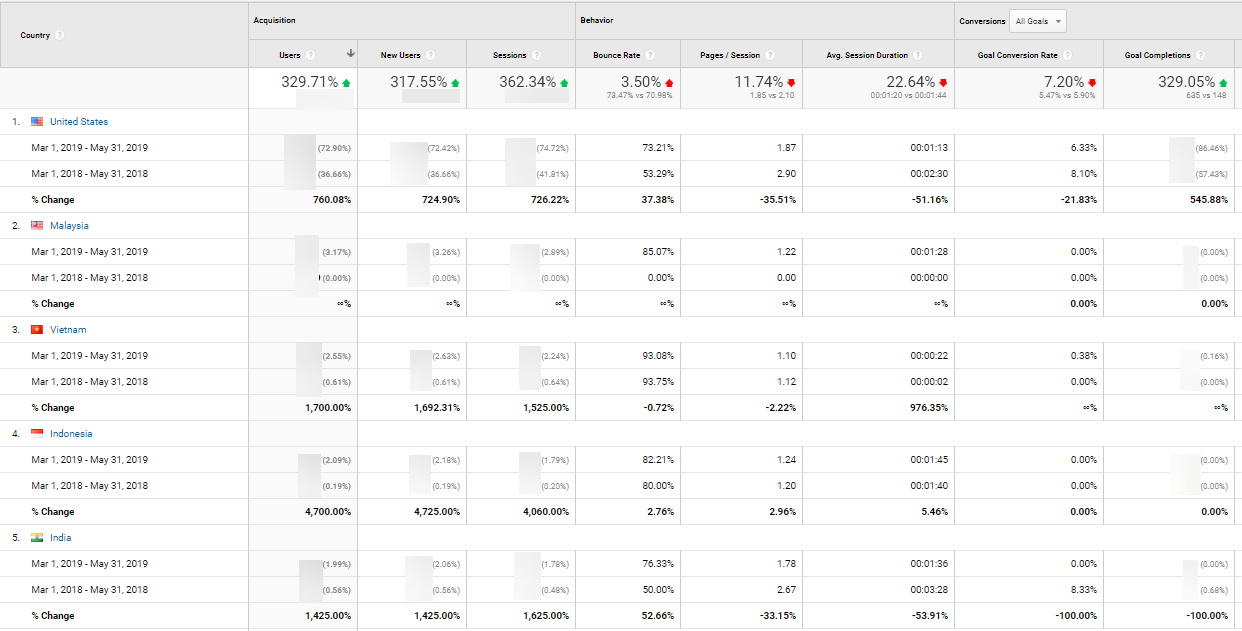
Evaluating how each location performs regarding conversions would be best, as it may provide valuable insights. In the above example, countries outside the USA report high traffic but not high conversions.
This could be improved if the school refined its website to speak to international audiences better.
There might be some pleasant surprises in store for your school, too.
You may have found a high-value new audience if you have overlooked these markets.
Take Time to Review Your Website
It would help to examine where your online traffic is coming from.
Reviewing your website traffic by source will allow you to discern which channels best drive interested prospects to your website.
Example: This channel report in GA shows organic and paid search driving the most traffic for a school, with small supplemental traffic from referrals, direct traffic, and social media.
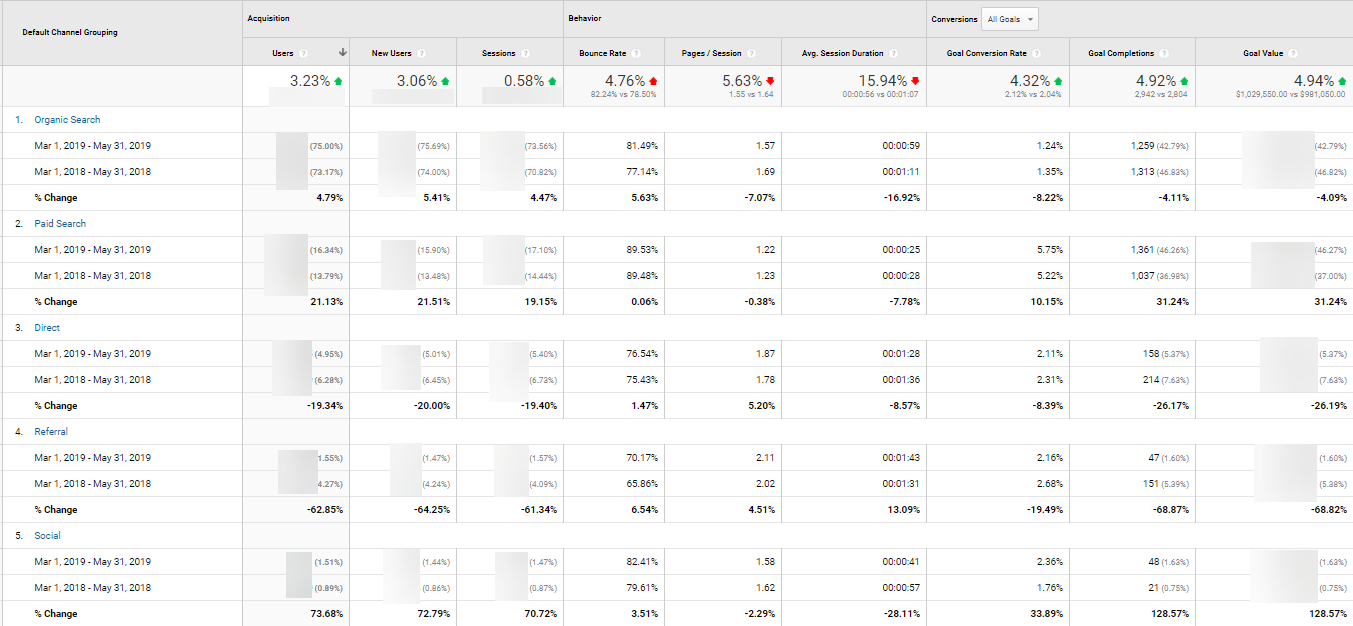
You might change your approach or devote more resources to underperforming channels, such as specific social networks, depending on your results and goals.
Alternatively, you may decide it’s more prudent to double your efforts on channels where you are already performing well, investing more resources to get an even higher return.
While it’s good practice to review all of this data regularly anyway, doing so within the broader context of an audit will help you make connections you didn’t see before and discover deeper meanings behind the numbers.
A Business School Digital Marketing Audit Can Help You Track Conversions More Accurately
Almost any activity on your website can be tracked to help measure the health of your online presence.
In Google Analytics, your school can create goals to measure everything from minor indicators of interest and engagement (micro-conversions) to severe milestones in the enrolment journey (macro-conversions).
Some of the conversions which might be necessary for your school to track would include:
- Form completions
- Event registrations
- Newsletter subscriptions
- Conversions from advertising campaigns
- Downloads of brochures and other materials
- Page and video views
- CTA clicks
- Online application submissions
Further Understanding a Digital Marketing Audit for Business Schools
A digital marketing audit for business schools can help you better define these goals.
Analytics experts can go through your website with a fine-tooth comb to identify and categorize different conversion opportunities and create a comprehensive plan your team can implement.
An audit can also help identify errors and technical issues that could make your tracking inaccurate.
For instance, a common problem some business schools have concerns the efficacy of cross-domain tracking.
If your school is part of a university, your site may exist on a subdomain of the larger institution.
Example: The website of Rotman School of Management, the University of Toronto’s business school, is a subdomain of the larger institution’s main utoronto.ca site.

If not appropriately configured, prospects navigating from the subdomain to the leading site and vice versa could be incorrectly labeled as a referral or direct traffic, meaning your reporting will not correctly reflect the channels from which your leads are coming.
Other common issues that audits can raise include improper use of tracking codes and the suboptimal classification of Google Analytics goals—e.g., goals that are being tracked as event goals (such as a website click or form submission) but would be more accurately tracked as destination goals (reaching a specific URL, such as a thank you page).
An Audit’s Findings Can Help Improve SEO for Business Schools
Search algorithms are complex systems that account for various factors, and everything from page architecture to inbound and outbound links to page speed and mobile-friendliness can affect your school’s rankings.
Digital marketing audits for business schools can be an opportunity to examine every element that could influence your visibility in important searches.
As a starting point, your school can define a list of priority keywords it should target. This can include search terms specific to your programs, localized keywords, or any other keywords that might be highly relevant to your target audience.
Example: An excerpt from a recommended keywords list for a business school.

With a defined list of target keywords, your team can see how well it ranks in specific searches and strategize ways to improve.
An audit from SEO experts can help you in this process by providing a detailed list of on-page and off-page SEO recommendations that you can implement to increase your chances of achieving more visibility.
Some common recommendations might include:
- Reviewing and optimizing page titles and meta descriptions
- Optimizing header tags (H1s, H2s, etc.) and ensuring they are being used correctly
- Redirecting 404 error pages
- Removing or redirecting broken links from your site
- Removing, deferring, and compressing elements on certain pages to improve loading speeds
- Creation of new content for SEO purposes
While they may seem complex, most of these issues are often quick fixes that could positively affect your visibility.
Analyzing Your Business School’s Competitors
One of the most valuable parts of a digital marketing audit can be comparing your efforts to those of your main competitors.
Going channel by channel, you can assess how much visibility and engagement other institutions generate, what techniques they employ, and how strong their presence is compared to yours.
The results can be particularly instructive and pave the way for both small-scale and large-scale improvements your school can implement.
You might find, for instance, that your competitors rank more highly than your school in several key searches or enjoy more visibility in certain target markets.
Example: In a Montreal-based search for the keyword business master’s programs, Schulich School of Business, Rotman School of Management, Smith School of Business, McGill University, and Alberta School of Business all rank in the top six. This is likely a highly desirable keyword for each of these schools.
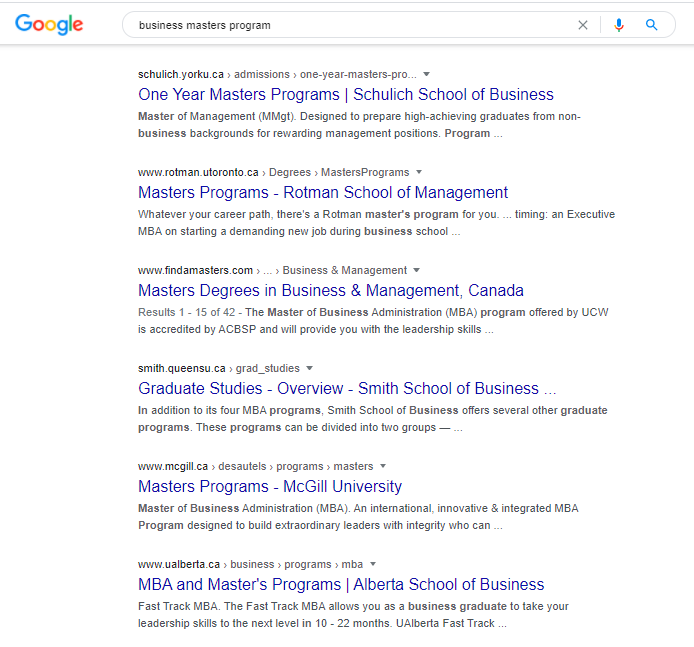
Armed with this information, you might focus more resources on improving your organic SEO or even supplementing your efforts with paid search advertising to improve your chances of reaching prospects more immediately.
Learn From Your Competitors
You may also be able to learn from your competitors’ creative strategies across digital channels.
For example, they might have a particularly active, engaged community on LinkedIn, demonstrate thought leadership when creating blogs and news articles, or even have a more intuitively designed website.
In these situations, your school might be able to take inspiration from their strategies and adapt their approaches to your initiatives.
Example: This is the homepage of Schulich School of Business, the top-ranking school in the above search.

This is the Smith School of Management homepage, which ranked fourth in the search.
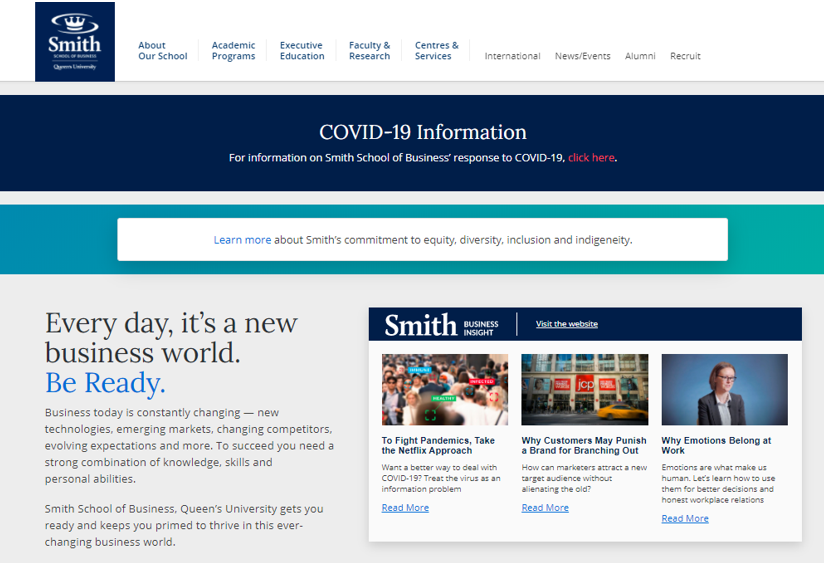
Which website leaves a better first impression? What could they learn from each other to improve? Analyzing your competitors can often be as simple as asking these questions.
To take this to the next level, an audit could include a mystery shopping component, where team members pose as potential applicants and submit inquiries to your competitors to assess their follow-up processes.
Do they follow up more quickly than you?
Do they attempt to contact by email, phone, SMS, or a combination of different channels? What features and benefits do they emphasize in their lead nurturing efforts to convince students to choose their school?
This exercise will help you better understand how you measure up and decide how to utilize your resources best to improve.
Auditing Your CRM and Marketing Automation Processes
Digital marketing can also drive many aspects of your internal admissions process.
From how you segment and categorize the leads you generate online in a CRM to using marketing automation processes to streamline your lead generation and follow-up, the digital aspects of your activities can determine their efficiency and effectiveness.
A business school digital marketing audit allows experts to review your CRM and marketing automation software accounts and their setup, including your staff’s roles and permission levels, the stages in your lead lifecycle, and your reporting.
They may be able to suggest better ways to organize your team or draw your attention to functionalities in your system that you were not utilizing.
Example: Lead scoring – seen here in action in HubSpot – is a common feature of many CRM and marketing automation platforms but is not always widely used by business schools.
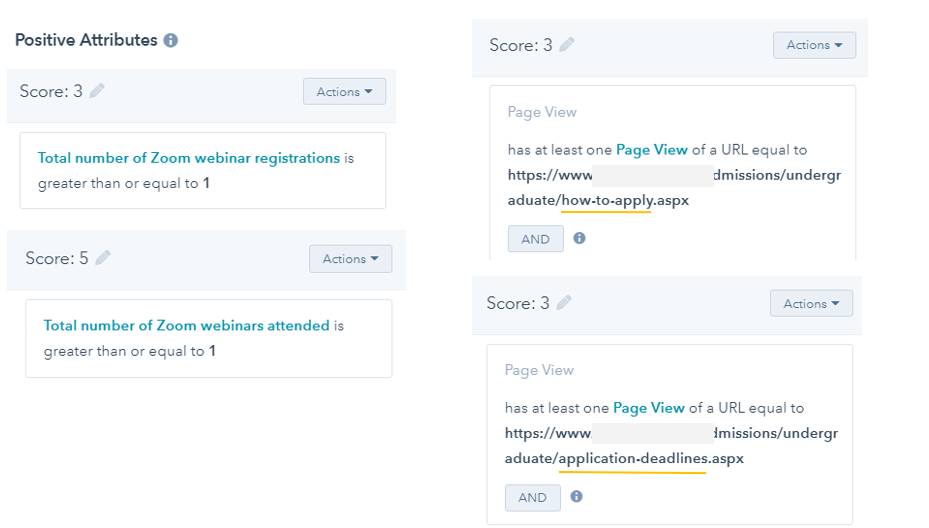
It is also an opportunity to review your various marketing automation assets, including CTAs, forms, emails, and landing pages, and evaluate their design, copy, campaign use, and alignment with your marketing goals.
In addition, an audit carried out by marketing automation experts can reveal errors in reporting, workflows, and other more technical marketing automation functions that can cause problems in helping you move prospects down the funnel towards enrolment.
For instance, many business schools use complex email workflows for certain campaigns, often containing small mistakes that might prevent them from working correctly.
Other Areas You Can Evaluate in a Digital Marketing Audit for Schools
A digital marketing audit can analyze your presence across several online channels and evaluate social media marketing for business schools to ensure your posting strategies effectively reach prospective students.
It can also refine your content marketing strategy, evaluate the ROI of your paid advertising efforts, or analyze the UX of your web design.
FAQ To Consider
What is an example of a business marketing audit?
If you have never created target Student Personas for Business Schools, a digital marketing audit might be a good time to do it.
Personas will allow you to clearly describe a typical member of your target audience, including their demographic characteristics, goals, and pain points.






